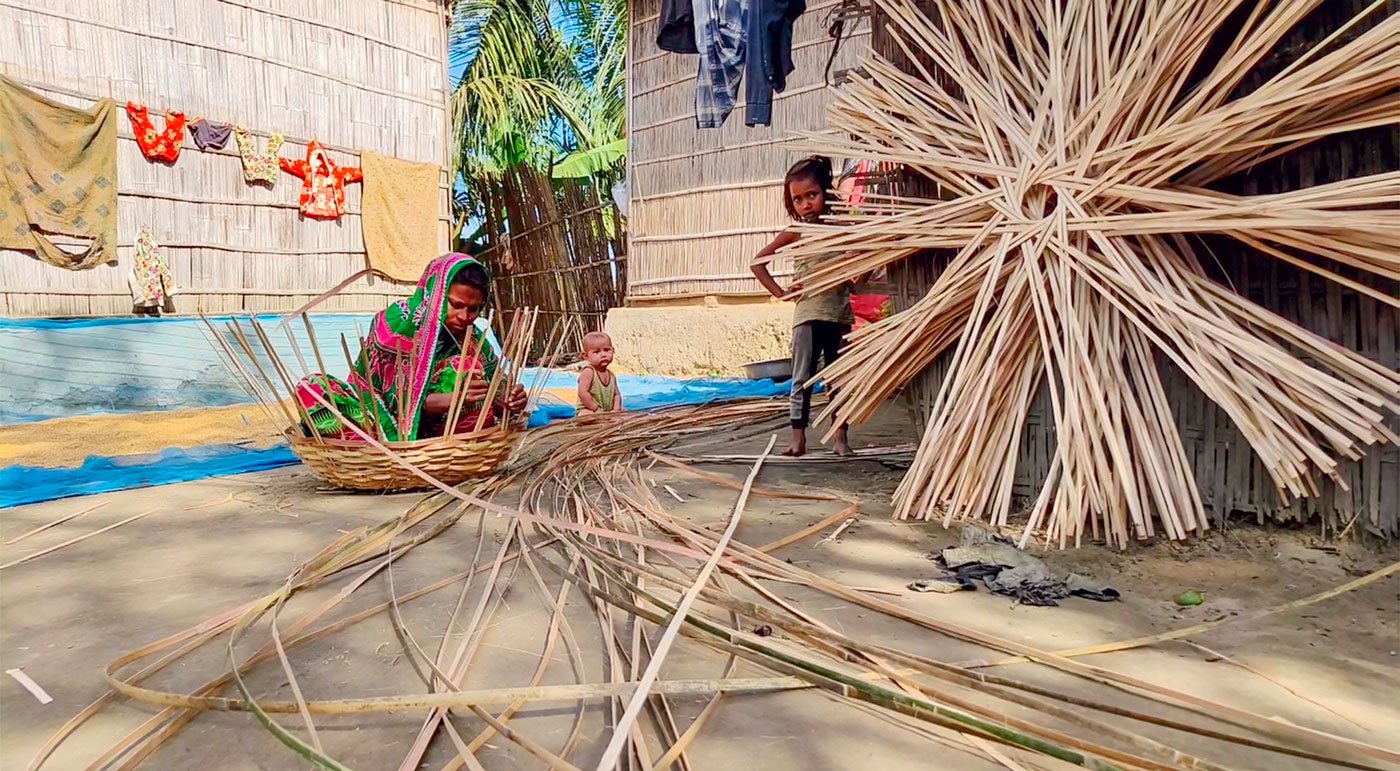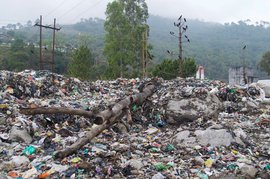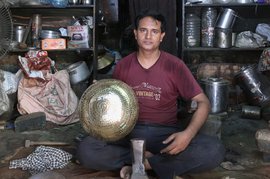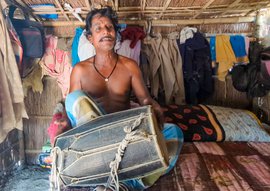“If this profession vanishes, I will have no option but to go to another state,” rues Majeda Begum, a bamboo basket maker from Na-mati village in Assam’s Darrang district, as she spins thin strips of bamboo around the base of the basket.
The 25-year-old craftswoman is a daily wage worker and single mother, supporting her 10-year-old son and ailing mother. “I can make up to 40 khasa s [baskets] in a day, but now I only weave 20,” she says in the local Miya dialect. With the fall in demand, Majeda earns Rs. 160 for every 20 baskets she weaves which is well below the state’s minimum wage of Rs. 241.92 for scheduled employment (Report on Minimum Wages Act, 1948 for the year 2016 ).
The returns from selling bamboo baskets have been affected by both the rising price of bamboo and falling demand for the baskets in the vegetable mandis here. Darrang hosts two of Assam’s biggest mandis : Bechimari and Balugaon from where agricultural produce is supplied all across the northeast and as far as Delhi.
Majeda’s fears of forced migration are real:
Around 80 to 100 families have left already in search of “better work”, says
39-year-old Hanif Ali, as he shows us around Ward A, located near the local
madrasa
. Roughly 150 families were once
involved in bamboo craft, but now, many homes lie vacant as the craftspeople
have migrated to other states like Kerala and Karnataka to work in coffee
plantations.


Left: Majeda Begum in Na-mati village of Assam's Darrang district, is a bamboo basket weaver and can make up to 40 baskets in a day but now makes half of that due to the decreasing demand. Right: Hanif Ali demonstrates the process of making toli or the base frame of the baskets which is the first step in the weaving process


Left: Siraj Ali, who runs his family's bamboo basket business, says that plastic containers are responsible for the decline in the demand of their wares. Right: Jamila Khatun cannot migrate to other states because her two children go to school in the village
Since the Covid-19 lockdown, sales have fallen sharply. “Earlier, we used to sell 400 to 500 khasas each week, but now we are only able to sell 100 to 150,” says Siraj Ali. The 28-year-old runs his family’s bamboo basket business. “Vegetable traders started using plastic trays and sacks to pack and store their produce during the pandemic. We could not sell our tukris [small bamboo baskets] during that time,” he adds.
Siraj lives in Ward A with his family of five. “Despite all of us working, we make only 3,000–4,000 rupees in a week,” he says. “After paying wages to the labourers, and expenses incurred in procuring bamboo, my family’s earnings come down to 250–300 rupees a day.” As a result, many members of his extended family have migrated to Karnataka to work in coffee estates. “If things continue like this, I will also have to go,” he says.
But not everyone can leave. “I cannot go to Kerala [as a migrant] because my two children are going to school here,” says 35-year-old Jamila Khatun, another basket-weaver, sitting in her house. Like most other homes in the village, hers too has no toilet or gas cylinder connection. “We cannot afford private schools. If we migrate, the children’s education will be ruined,” this resident of Na-mati adds.
The bamboo basket weavers of the village are
mostly descendants of migrants from Mymensingh in present-day Bangladesh who
had left their homes when it was still a part of undivided Bengal during
colonial rule. The word ‘Miya’, literally meaning ‘gentleman’ is often used
pejoratively by Assamese ethno-nationalists to describe the Bangla-speaking community as
“illegal settlers” in the state.


Left: Na-mati village is the hub of bamboo basket weavers, most of whom belong to the Miya community. Right: Miyaruddin has been weaving baskets from a young age. He sustains his family of five by selling bamboo baskets


The base (left) determines the size of the basket. Once the base is made, women begin weaving (right) thin strips into it
Na-mati village, located about 110 kilometres from Guwahati, is the hub of bamboo craft in Darrang district, especially the traditional baskets known locally as khasa . Mud-roads and alleyways lead to the two clusters of roughly 50 families where these Bengali-speaking Muslims live in densely packed bamboo-thatched or tin-walled houses and a few concrete homes, on the flood plains of the Tangni river.
The name of the area – Khasapatti – means ‘bamboo basket neighbourhood’ and most homes here are surrounded by piles of bamboo baskets. “Since before I was born, people from our area have been supplying bamboo baskets to daily and weekly vegetable markets at Lalpool, Bechimari and Balugaon mandis ,” says 30-year-old Murshida Begum, as she weaves outside her home in the chapori cluster.
Three generations of Hanif’s family have been involved in the trade. “Bring up Khasapatti, and people will know it’s this village you are talking about. Though not everyone is engaged in the craft, this is where the first generation of khasa weavers started their work.”
Hanif is trying to form a registered self-help group (SHG) of bamboo craftspeople in the village to obtain government assistance to sustain the craft. “If the government provides us technical and financial help to set up a workshop, this craft will survive,” he hopes.
The primarily Muslim community who engage in this craft, say they took it up because they were landless and could not practise agriculture. “Bamboo baskets are an integral part of the chain of vegetable trade, as the region is dependent on agriculture,” says 61-year-old Abdul Jalil, a basket weaver and social worker from Ward A.
“The locals needed tukris to take their produce to the markets and vendors needed them to package the vegetables for transportation. Hence, we have been making these baskets for generations,” he explains.


Left: Several families from Murshida Begum's area have migrated to other states such as Karnataka and Kerala. Right: Abdul Jalil, a basket-maker and social worker says, ' We put our blood and sweat into this work, but do not get a fair price'


Left: Munser Ali has been selling bamboo to basket makers at f or more than two decades Right: With a decline in sales, baskets pile up in the weavers' home
The workers also attribute the higher prices of bamboo baskets to higher expenses incurred in procuring the raw material. Afaj Uddin, a 43-year-old bamboo craftsman from the chapori cluster, says that for each basket priced at Rs. 50, they have to spend around Rs. 40 including the cost of bamboo, thread, paying the weavers and local transport.
Munser Ali has been sourcing bamboo from various places and selling it at Bechimari bazaar for more than two decades. The 43-year-old says that transportation is the chief hurdle. The Motor Vehicles (Amendment) Act, 2019 levies a fine of Rs. 20,000 for overloading a vehicle, and Rs. 2,000 per extra tonne of load.
The Handicraft Policy of Assam ( 2022 ), however, stipulates that the responsibility of sourcing the bamboo lies with the State Bamboo Mission, other agencies of the forest department and the panchayats.
With the rise in prices, Munser Ali has lost his
key customers – the bamboo basket makers. “They have to buy each bamboo cane
for Rs. 130–150,” he says. “If they have to sell it for Rs. 100, then what is
the point?”
*****
The elaborate process of making khasas starts with sourcing the bamboo, says Abdul Jalil. “Some 20 or 30 years ago, we used to go to villages in Darrang to collect bamboo. But as it became scarce here with a decline in bamboo plantations, traders started to supply it from various places like Karbi Anglong and Lakhimpur districts, or from Arunachal Pradesh and other hilly areas.”
Many families in Na-mati were involved in bamboo crafts. Now homes lie vacant as craftspeople have migrated to Kerala and Karnataka to work in coffee plantations
Once the bamboo tree is brought to a weaver’s home, the men in the family cut betees (strips) of varying sizes ranging from 3.5 feet to 4.5 feet from the bottom to make the base of a basket. Strips of eight, 12 or 16 feet are cut from the middle to make the connecting strands and the upper culm is used to make the strips for finishing the top of the basket.
The relatively thicker strips are used to make the toli (base or frame) of a basket. “ Toli defines the size of the basket. Once the base is made, women and children weave lithe strips by spinning them from the centre. These strips are called pechni betee ,” explains Jalil.
“At the top, two or three rounds of stronger strips are used to end the weaving process which we call pechni . To finish the basket, the remaining ends of the base are broken and inserted into the woven bamboo threads. We call the process muri bhanga ,” he adds.
The entire process, Murshida says, is done by hand: “To cut the bamboo into the required sizes, we use a hacksaw. We use a kurhail [axe] or a dao [machete] to slice the bamboo stems. To make the bamboo threads, we use very sharp machetes. To bind the top ends of the baskets, we use a batali [chisel]-like tool to insert the remaining ends of tolir betee into the pechni betee .”
Each basket takes around 20 to 25 minutes to weave; this, excluding the process of muri bhanga and toli bhanga . On the day before the weekly market, women sometimes work well into the night to craft as many baskets as possible. The work takes a toll on their physical health.
“We get back pains, calluses in our hands, we get pricked by the sharp parts of the bamboo,” Murshida says. “Sometimes needle-like pieces of bamboo pierce through our skin, causing severe pain. Before the weekly markets, we work late into the night and the next day, we cannot sleep due to the pain.”
This story is supported by a fellowship from Mrinalini Mukherjee Foundation (MMF).




